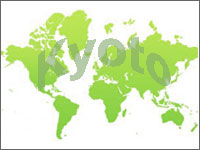Kyoto Goes Global
 Vancouver, Canada (GLOBE-Net) - Links between the United Nations Climate Change Secretariat’s (UNFCCC) International Transaction Log (ITL) and the European Union (EU) greenhouse gas emissions trading system (EU ETS) went operational this morning.
Vancouver, Canada (GLOBE-Net) - Links between the United Nations Climate Change Secretariat’s (UNFCCC) International Transaction Log (ITL) and the European Union (EU) greenhouse gas emissions trading system (EU ETS) went operational this morning.With this connection, the Kyoto trading system now has the critical mass needed to allow governments and other legal entities to exchange and use emissions rights on a global scale. It also allows them to take advantage of credits stemming from the Clean Development Mechanism (CDM) and Joint Implementation flexibility mechanisms of the Kyoto Protocol.
"ETS go-live has been a high priority project for the UNFCCC secretariat. We have worked closely with the European Commission and the EU member states in coordinating the extensive preparatory work that was necessary to achieve the full connectivity of the ETS registries to the ITL; we are now very pleased by its clear success," said UNFCCC Executive Secretary Yvo de Boer.
’This event finalizes the infrastructure required for successful operation of all flexibility mechanisms under the Kyoto Protocol,’ the UN’s top climate change official said. ’In terms of carbon market, ETS go-live with the ITL expands the market size of carbon allowances in industrialized countries from about 24 billion tonnes CO2 equivalent to almost 50 billion. In addition, the CDM is expected to add another 100 million credits to the market.’
Global markets in carbon emissions permits have grown by 81 percent so far this year and will top $100 billion in 2008, according to research company New Carbon Finance (NCF). Growth in the hub of global carbon trading system - the European Union emissions trading scheme - masked a fall elsewhere in tradable offsets traded between rich and poor countries under the Kyoto Protocol, notes NCF’s Guy Turner.
Similar estimates have been confirmed by the World Bank and the clean-technology research and analytics firm New Energy Finance.
"The ITL-CITL link will improve liquidity," adds Turner, referring to the link between trading registries under the EU ETS and the Kyoto Protocol’s clean development mechanism (CDM).
The UNFCCC secretariat plans to link the registries of Iceland, Liechtenstein, Norway, and the Ukraine by the end of November. At that time almost all industrialized countries with emission reduction targets under the Kyoto Protocol will have full access to the implementation of market-based mechanisms.
’The complete architecture of the Kyoto Protocol becomes fully operational this year. We have explicit emission reduction targets in place for most industrialized countries; we have established a credible, comprehensive system for reporting and verifying GHG emissions; and now we are completing the infrastructure for using the carbon market as a cost-effective means for meeting the targets,’ emphasized Mr. de Boer.
In North America two major developments with respect to carbon trading systems took place n recent weeks. The Western Climate Initiative (WCI) - consisting of seven Western states and four Canadian provinces - announced final recommendations for the design of its regional market-based cap-and-trade program. The WCI aims to reduce regional GHG emissions by about 15 percent below 2005 levels in 12 years.
The first auction of permits under the Regional Greenhouse Gas Initiative - consisting of ten states in Northeast United States - took place in late September. Permit sales allowing power plants to emit greenhouse gases reached nearly $39 million, which member states plan to use to protect consumers from any higher energy bills that could result from capping the pollution.For More Information: UN Framework Convention on Climate Change
You can return to the main Market News page, or press the Back button on your browser.

